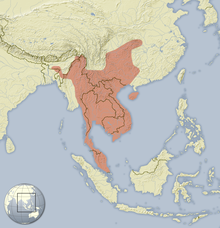Asian tassel spike
| Asian tassel spike | ||||||||||||
|---|---|---|---|---|---|---|---|---|---|---|---|---|

Asiatic tassel spike ( Atherurus macrourus ) |
||||||||||||
| Systematics | ||||||||||||
|
||||||||||||
| Scientific name | ||||||||||||
| Atherurus macrourus | ||||||||||||
| ( Linnaeus , 1758) |
The Asiatic tassel spike ( Atherurus macrourus ) is a species of porcupine from the genus of the tassel spike ( Atherurus ). It occurs in Asia from the south of the People's Republic of China to India and Southeast Asia.
features
The Asian tassel spike reaches a head-trunk length of 34.5 to 52.5 centimeters, the tail length is 13.9 to 22.8 centimeters and the weight is between two and four kilograms. The hind foot becomes 64 to 75 millimeters long, the ear length is 30 to 36 millimeters. It is therefore comparatively large for a rodent, but within the porcupine it is relatively small with a comparatively long tail and short legs. The back is covered with flat and notched spines, the spines on the ventral side are soft and thin. The tail is scaly and ends in a tassel of white, about 20 centimeters long and hard spiked bristles. The females have two side teats .
The skull length is 83 to 120 millimeters. The nasal bones are narrow and short and reach a length of less than 30% of the length of the skull and the foremost area only extends about 3 to 4 millimeters beyond the anterior margin of the intermaxillary bone . All molars have a complete tooth root.
distribution
The Asian tassel spike occurs in Asia from the south of the People's Republic of China to India and Southeast Asia. In India it lives in Assam and it is likely to be found in neighboring Bangladesh as well. In China, the distribution area includes the provinces of Sichuan , Guizhou , Yunnan , Hubei , Hunnan and Guangxi as well as the island of Hainan . In Southeast Asia, it spreads over Myanmar , Thailand with the island of Tarutau , Cambodia , Laos , Vietnam and the mainland of Malaysia . The species has also been documented on the island of Sumatra , part of Indonesia , but has not yet been confirmed.
Way of life
The Asian tassel spike lives on the ground in dense subtropical and tropical mountain forests, probably predominantly with stony soils and plenty of undergrowth with sugar cane and bamboo plants . It is nocturnal and primarily living on the ground, but can also climb trees and bushes. The animals feed mainly herbivorous of roots, tubers and green plant parts. They live in buildings they have dug or taken over, which can also be connected and accommodate up to three individuals. The females produce up to two litters per year and after a gestation period of 100 to 110 days give birth to one or, less often, two young animals, which are very quickly active as nests . They leave the maternal burrow after about a week when the spines have hardened.
Systematics
The Asian tassel spike is classified as an independent species within the genus of the tassel spike ( Atherurus ), which consists of two species and in addition to it also contains the African tassel spike ( A. africanus ). The first scientific description comes from Carl von Linné from 1758, who described the species in the 10th edition of his Systema naturae .
Apart from the nominate form according to Wilson & Reeder 2005, no subspecies are differentiated within the species, but Smith & Yan Xie 2009 give two subspecies for the Chinese part of the distribution area: The nominate form A. m. macrourus on mainland China and the island form A. m. hainanus on Hainan Island .
Status, threat and protection
The Asian tassel spike is classified by the International Union for Conservation of Nature and Natural Resources (IUCN) as Least Concern. This is justified with the large distribution area and its occurrence in several protected regions as well as the only slight decline in stocks, which does not justify inclusion in a hazard category. Especially in South Asia, the species is endangered locally by the conversion of forest areas into agricultural areas, the removal of wood from habitats, as well as hunting and accidents.
supporting documents
- ↑ a b c d e f Andrew T. Smith: Asiatic Brush-Tailed Porcupine. In: Andrew T. Smith , Yan Xie: A Guide to the Mammals of China. Princeton University Press, Princeton NJ 2008, ISBN 978-0-691-09984-2 , p. 274.
- ↑ a b c d e Atherurus macrourus in the Red List of Threatened Species of IUCN 2015-4. Posted by: D. Lunde, S. Molur, 2008. Retrieved December 14, 2015.
- ↑ a b Atherurus macrourus ( Memento of the original dated December 22, 2015 in the Internet Archive ) Info: The archive link was inserted automatically and has not yet been checked. Please check the original and archive link according to the instructions and then remove this notice. . In: Don E. Wilson , DeeAnn M. Reeder (Eds.): Mammal Species of the World. A taxonomic and geographic Reference. 2 volumes. 3. Edition. Johns Hopkins University Press, Baltimore MD 2005, ISBN 0-8018-8221-4 .
literature
- Andrew T. Smith: Asiatic Brush-Tailed Porcupine. In: Andrew T. Smith , Yan Xie: A Guide to the Mammals of China. Princeton University Press, Princeton NJ 2008, ISBN 978-0-691-09984-2 , p. 274.
Web links
- Atherurus macrourus inthe IUCN 2015-4 Red List of Threatened Species . Posted by: D. Lunde, S. Molur, 2008. Retrieved December 14, 2015.
